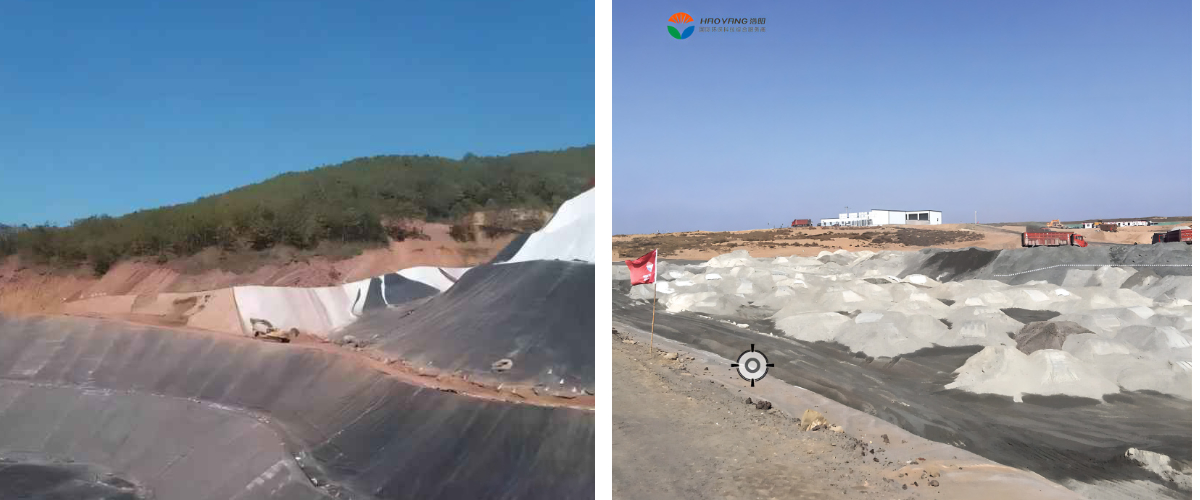1mm Black Composite Geomembrane for Ultrafine Fly Ash Solid Waste Disposal Project
1mm black composite geomembrane plays a pivotal role in the success of the Ultrafine Fly Ash Solid Waste Disposal Project. Geomembrane serves as a critical barrier, effectively containing and isolating the ultrafine fly ash solid waste from the surrounding environment. Its thickness of 1mm ensures robust durability and impermeability, providing a reliable defense against potential leaks and environmental contamination.
The black color geomembrane is particularly advantageous as it enhances heat absorption, promoting the evaporation of moisture within the waste disposal area. This aids in maintaining the stability of the waste material and prevents the formation of undesirable conditions such as leachate. Additionally, the geomembrane acts as a protective layer, safeguarding the underlying soil and groundwater from potential pollutants.
1, Leakage Issue: In the process of the Ultrafine Fly Ash Solid Waste Disposal Project, there is a potential risk of leakage. The waste material may permeate into the surrounding environment or groundwater, leading to environmental contamination and resource wastage.
2, Moisture Evaporation Issue: The generation of moisture during the treatment process can impact the stability of the engineering, introducing unfavorable conditions such as the formation of leachate, thereby affecting the effectiveness of waste disposal.
3, Pollution Protection Issue: The project needs to effectively protect the underlying soil and groundwater from potential pollutants present in the ultrafine fly ash.
1, Anti-leakage Solution: Utilizing a 1mm black composite geomembrane as a crucial isolation layer effectively prevents the leakage of ultrafine fly ash waste. This ensures its safe and controlled handling, minimizing adverse impacts on the surrounding environment.
2, Moisture Evaporation Solution: Opting for a 1mm black composite geomembrane with enhanced heat absorption characteristics facilitates the evaporation of moisture, thereby maintaining the stability of the waste disposal area and mitigating the negative effects associated with excessive moisture.
3, Pollution Protection Solution: The geomembrane not only serves as an anti-leakage layer but also functions as a protective barrier, safeguarding the underlying soil and groundwater from potential pollutants. This enhances the environmental protection standards and long-term stability of the project.
Filament composite black geomembrane refers to a geosynthetic membrane composed of long fibers (or filaments) and black geomembrane, it has three layers, in the middle is black geomembrane and two sides are filament nonwoven geofabrics.
Its main functions include:
1, Anti-leakage: Long-fiber composite geomembranes typically possess high impermeability and sealing properties. They effectively isolate and prevent the infiltration of water, chemicals, or waste into the soil or groundwater, preventing environmental contamination.
2, Strength and Durability: Long-fiber materials provide the geomembrane with higher strength and durability. This allows it to withstand external pressures such as groundwater pressure and soil deformation, maintaining long-term stability.
3, Heat Absorption: The black color of the geomembrane facilitates more effective heat absorption, promoting the potential evaporation of moisture. This feature is advantageous for maintaining stability, especially in projects dealing with moist waste materials.
4, Environmental Protection: By preventing leakage and contamination, long-fiber composite black geomembranes contribute to an elevated level of environmental protection in engineering projects, ensuring the quality of underlying soil and groundwater.
In summary, the main functions of a long-fiber composite black geomembrane in engineering include providing comprehensive properties such as anti-leakage, strength, durability, and environmental protection. It is particularly suitable for applications requiring the prevention of contaminant infiltration
Our factory covers an area of over 230 acres with more than 40,000 square meters of standardized industrial workshops. The company boasts over 26 modern production lines for geosynthetic materials, with a total annual production capacity of 73,500 tons..




